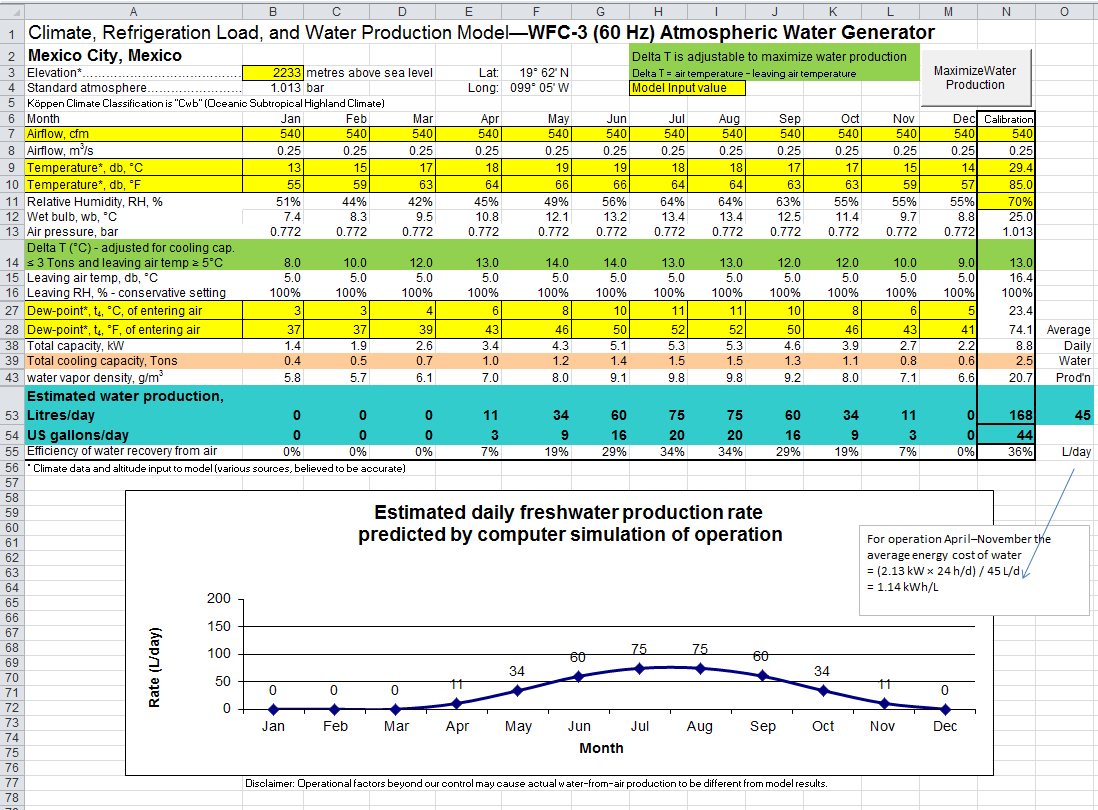Water-scarce Mexico City is a challenging location for the operation of water-from-air machines that use mechanical dehumidifier technology. The high elevation (2,233 m) means that for its latitude, the water vapour density of the ambient air is quite low, with the annual range from 5.8–9.8 grams of water per cubic metre of moist air. Because the water-from-air resource is low, the machine's water production is low compared to the manufacturer's rating. Therefore, the energy cost of the water is relatively high, averaging 1.14 kWh per litre of water produced during the April to November operating season. Nevertheless, there may be certain businesses that would find the an additional source of clean, fresh water useful and worth the premium. Examples include restaurants, food manufacturers, clinics, and hotels.
To find the machine refrigeration capacity (in tons of refrigeration*) needed for various water production capacities we can take advantage of the linear relationship between water production and refrigerating capacity. In the WFC-3 example here—and accepting the shortened operating season from April to November—we see that water production of 45 L/d (see text box on the right of the graph above) needs 3 tons of refrigeration capacity. Or, we can say that 15 L/d needs 1 ton of refrigeration capacity. We can construct the following table:
1 ton produces 15 L/d
10 tons produces 150 L/d
100 tons produces 1500 L/d
1000 tons produces 15,000 L/d
The largest machine manufactured by Water Technologies International, Inc. is the WFC-200 with 200 tons of refrigerating capacity. Therefore, to produce 15,000 L/day would require five WFC-200 units whose current price (ex works) is USD 421,200 each.
To avoid unsustainable up-front capital costs for water-from-air projects, it can be advantageous to recognize that installations need not be centralized (because water in the air is everywhere). Rather, smaller machines can be purchased as funds allow and be installed gradually in networks of independent machines serving the populations of neighbourhoods.
*ton of refrigeration = Refrigeration power needed to melt 1 ton of ice per 24 hours (288,000 Btu per day, 12,000 Btu per hour) = 3.517 kW
To find the machine refrigeration capacity (in tons of refrigeration*) needed for various water production capacities we can take advantage of the linear relationship between water production and refrigerating capacity. In the WFC-3 example here—and accepting the shortened operating season from April to November—we see that water production of 45 L/d (see text box on the right of the graph above) needs 3 tons of refrigeration capacity. Or, we can say that 15 L/d needs 1 ton of refrigeration capacity. We can construct the following table:
1 ton produces 15 L/d
10 tons produces 150 L/d
100 tons produces 1500 L/d
1000 tons produces 15,000 L/d
The largest machine manufactured by Water Technologies International, Inc. is the WFC-200 with 200 tons of refrigerating capacity. Therefore, to produce 15,000 L/day would require five WFC-200 units whose current price (ex works) is USD 421,200 each.
To avoid unsustainable up-front capital costs for water-from-air projects, it can be advantageous to recognize that installations need not be centralized (because water in the air is everywhere). Rather, smaller machines can be purchased as funds allow and be installed gradually in networks of independent machines serving the populations of neighbourhoods.
*ton of refrigeration = Refrigeration power needed to melt 1 ton of ice per 24 hours (288,000 Btu per day, 12,000 Btu per hour) = 3.517 kW
